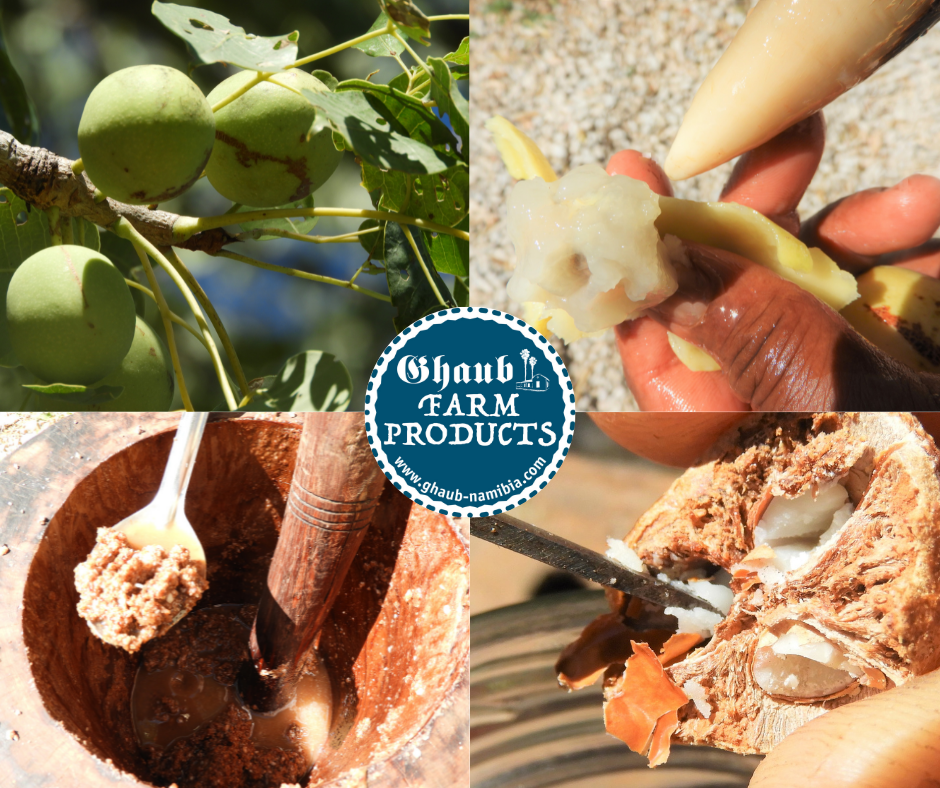In our farm kitchens the fruits and now also the nuts are processed into various farm products. Find out more on this unique tree and its use.
The Marula is a botanical landmark on Ghaub.
The Marula has long been considered an important food source for humans and animals on the African continent. The fruit is high in protein and vitamin C. On Ghaub it is used to produce a wide variety of farm products.
The tree grows up to 15 meters tall, has a scaly bark and forms a rounded crown. A distinction is made between male and female trees (Dioecy). The fruits are ripe between January and March. Elephants are known to enjoy eating the often already fermenting fruits. Hence the common name “elephant tree”. Perhaps this is a interrelation to the famous elephant engraving on Ghaub. A separate newsletter is planned on the engravings themselves – stay tuned!
Juices, jellies and jams.
We can‘t help but eat some of the fresh fruits during harvest already. For the rest, the pulp is separated from the pit and processed into juices, jellies and jams. The pit contains three small nuts, which can be eaten fresh or roasted. Each pit is carefully cracked by hand to get to the inside.
The nut is rich in fats and oil. The latter is pressed out and used in our kitchens as cooking oil and salad dressing. A special taste experience for the guests of Ghaub and Waterberg Wilderness. Marula oil is an excellent and local alternative to sunflower oil, which is also becoming increasingly expensive. A traditional wooden pounder is used to get to the oil. A common tool in northern Namibia for grinding Mahangu (millet) and maize. To ease the workprocess, considerations to invest in a mechanical oil press are already discussed.
Overview of the tree population.
In order to get a better overview of the tree population, the agronomist Nadia Löffel, with the help of Caroline Rust, mapped and measured all Marula trees on Ghaub. At the same time, the sex of each tree was determined. In this way 281 trees were mapped and measured. For this, only trees that were easy to reach – a maximum of 100 m from the road – were measured. The coordinates were recorded using a GPS device and the circumference of the tree was measured 1 m above the ground. The sex could be determined by appearance: does the tree bear fruits (female) or an inflorescence (male).
The report shows that the sex distribution is balanced: 146 male and 135 female trees. It also concludes that the average tree circumference is 158 cm. The measured trees were classified healthy and the overall population is well-built. A very pleasing conclusion for guest and animal on Ghaub! We would like to thank Nadia and Caroline for providing their visuals and research materials. Due to the limited selection of images in this newsletter, we were not able to show everything. We recommend following our social media channels to get further insight into their research.
The marula tree still holds a great potential for the agricultural production on Ghaub. The existing guest operations of ONE Namibia can be optimally used as sales channels for all kinds of Marula- and farm products. Got the taste for it? Join us and become a part of the big picture.

281 Marula trees were mapped and measured on Ghaub




